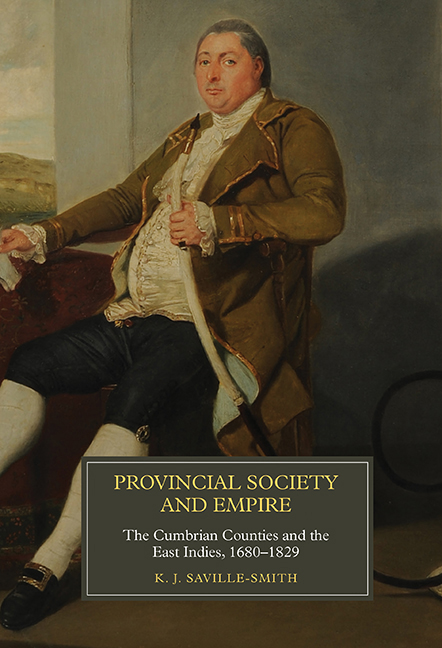Book contents
- Frontmatter
- Contents
- List of Illustrations
- Acknowledgements
- List of Abbreviations
- Glossary
- Chapter 1 The Provincial World and Global Encounters
- Chapter 2 Cumbrian Contexts, Patterns and Lives
- Chapter 3 Why Go to the East Indies?
- Chapter 4 ‘Passage to India’
- Chapter 5 Returning and Returns
- Chapter 6 Conclusion: ‘Use of Globes’
- Appendix A East Indies Enumerated Cumbrian Men
- Appendix B East Indies Enumerated Cumbrian Women
- Appendix C East Indies Women, Associated Cumbrian Men and Their Children
- Appendix D Hudleston, Kin Connections and the East Indies
- Appendix E East Indies connections of the Winders, Stephensons and Fawcetts
- Appendix F East Indies connections of the Braddylls, Wilsons and Gales
- Appendix G Kin Connections of Catherine Holme
- Appendix H Kin Connections of Thomas Cust
- Bibliography
- Index
- Miscellaneous Endmatter
Chapter 2 - Cumbrian Contexts, Patterns and Lives
Published online by Cambridge University Press: 18 April 2018
- Frontmatter
- Contents
- List of Illustrations
- Acknowledgements
- List of Abbreviations
- Glossary
- Chapter 1 The Provincial World and Global Encounters
- Chapter 2 Cumbrian Contexts, Patterns and Lives
- Chapter 3 Why Go to the East Indies?
- Chapter 4 ‘Passage to India’
- Chapter 5 Returning and Returns
- Chapter 6 Conclusion: ‘Use of Globes’
- Appendix A East Indies Enumerated Cumbrian Men
- Appendix B East Indies Enumerated Cumbrian Women
- Appendix C East Indies Women, Associated Cumbrian Men and Their Children
- Appendix D Hudleston, Kin Connections and the East Indies
- Appendix E East Indies connections of the Winders, Stephensons and Fawcetts
- Appendix F East Indies connections of the Braddylls, Wilsons and Gales
- Appendix G Kin Connections of Catherine Holme
- Appendix H Kin Connections of Thomas Cust
- Bibliography
- Index
- Miscellaneous Endmatter
Summary
1885 – C. W. Bardsley:
[S]he was married to Christopher Wilson, who had but recently purchased Bardsea Hall… Christopher was a sea captain in the Hon. East India Company's service, and like many another adventurer of that time, left it with his fortune made. He was a cadet… of a good Westmorland family… He wooed and won.
1965 – E. Hughes:
Ever since the days of Governor Pitt and ‘Galloper’ Curwen, Cumbrian youths of families with Jacobite or Non-Juror sympathies had entered the service of the East India Company.
1981 – J. V. Beckett:
By the late 1730s, with only Lowther and Edward Stephenson – a former East India Company nabob who had bought himself an estate near Keswick – lending money…
The East Indies became enmeshed in Cumbrian life in the eighteenth century with well over 400 Cumbrian men and women identified as directly involved in East Indies trade, the East India Company or East Indies sojourns. They were connected to, and supported by, many more Cumbrians. This chapter analyses the characteristics of the Cumbrians involved in the East Indies encounter, the structure of their relationships, and heralds the continuities as well as the heterogeneity of their East Indies encounters. It starts with a chronological overview of the context in which Cumbrians were operating, focusing on the alignment between the numbers of Cumbrian men appointed and licensed by the East India Company, the changing operations of the East India Company, and events shaping the British Isles in the global world.
The second section focuses on the patterns of encounter, compares rates of Cumbrian involvement in the East Indies with other counties, and explores the social characteristics and place origins of enumerated Cumbrian men. The social structure of Cumbria's encounter with the East Indies is uncovered by a systematic mapping of the networks between East Indies-involved families. The final section presents six chronologically arranged biographical narratives that highlight the way in which the pursuit of success in the East Indies comprised profound and persistent continuities, despite the social heterogeneity of Cumbrian sojourners, the diversity of their trajectories and outcomes for their families, and the chronological stretch of the long eighteenth century.
- Type
- Chapter
- Information
- Provincial Society and EmpireThe Cumbrian Counties and the East Indies, 1680–1829, pp. 31 - 66Publisher: Boydell & BrewerPrint publication year: 2018



